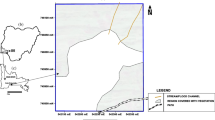Abstract
Different geophysical approaches including seismic refraction, electromagnetic resistivity with very low frequency and magnetics prospecting method were used to gain a richer and more complete understanding of subsurface environment in delineating the origin of the cracks on the buildings of the Faculty of Social Sciences and Humanities, Federal University Oye- Ekiti. Three (3) profiles of seismic refraction, Five (5) Very Low Frequency-Electromagnetic traverses, twenty-one (21) Vertical Electrical Soundings and three (3) magnetic profiles were occupied and investigated around the distress building. Three major layers were delineated in the study region comprising the topsoil, the weathered/fractured layer and the fresh basement. The VES curve types obtained were A, H, K and Q curves. The buildings were found to be situated within the area of a fairly high concentration of fractures that can aid subsidence in the area and relatively low resistivity zones typical of incompetent clay formation. The geovelocity layers’ characteristics substantiate the electrical resistivity imaging and vertical electrical sounding results as it revealed a 3-layer model namely: topsoil and basement bedrock as the weathered layer is blinded. The topsoil has average velocity 363 m/s which is diagnostic of weak/unconsolidated materials presumably clayey materials and average thickness of 1.7 m. The sub-weathering/ is blinded while the third layer is the bedrock with average velocity of 1183 m/s and characterized with a displaced parallel time segment indicating fault within the bedrock. From the result, the building failure observe as cracks and foundation subsidence may have been caused by the foundation soils that made up of incompetent materials (clay) which could compress on imposing loads by differential settlement. It is noteworthy that geological features such as fractures/faults delineated within the bedrock is also inimical to the building foundation.









Similar content being viewed by others
References
Ackermann HD, Pankratz LW, Dansereau D (1986) Resolution of ambiguities of shallow refraction travel-time curves. Geophysics 51:223–235
Adeleke BO, Leong GC (1978) Certificate physical and human geography, west, African edn. Oxford University Press, Nigeria
Adesida A, Omosuyi GO (2005) Geoelectric Investigation of Bedrock Structures in the Mini- campus of the Federal University of Technology, Akure, Southwestren Nigeria, and the geotechnical significance. Niger J Pure Appl Phys 4:32–40
Barry KM (1967) Delay-time and its application to refraction profile interpretation. In: Musgrave AW (ed) seismic refraction prospecting. Society of Exploration Geophysicists, Tulsa
Federal Ministry of Works and Housing (1972) Highway manual part 1 road design. Federal Ministry of Works and Housing, Lagos
Olorunfemi MO, Idoringie AI, Coker AT, Babadiya GE (2004) The application of the electrical resistivity method in foundation failure investigation. J Appl Geosci 2(1):139–151
Oyedele KF (2009) Engineering geophysical approach to progressive or sudden collapse of engineering structures in Lagos Nigeria. J Am Sci 5(5):91–100
Rahaman MA (1989) Review of the basement geology of southwestern Nigeria. In: Kogbe CA (ed) Geology of Nigeria. Rock View (Nig.) Limited, Jos
Sharma SK (1967) Response characteristics and stability of earth dams during strong earthquakes. PhD Thesis, Imperial College, University of London
Vander Velper BPA (1988) Resist Version 1.0, M.Sc. esearch Project, ITC. Delft, Netherlands
Venkatranmaiah C (2006) Geotechnical engineering. New Age International Limited Publisher, Chennai, pp 541–603
Walker C, Leung TM, Win MA, Whiteley RJ (1991) Engineering seismic refraction: an improved field practice and a new interpretation method. Explor Geophys 22:423–426
Whiteley, R.J., Eccleston, P.J., (2006) Comparison of shallow seismic refraction interpretation methods for regolith mapping: 18th ASEG Geophysical Conference and Exhibition, paper. p23
Author information
Authors and Affiliations
Corresponding author
Additional information
Publisher's Note
Springer Nature remains neutral with regard to jurisdictional claims in published maps and institutional affiliations.
Rights and permissions
About this article
Cite this article
Fajana, A.O. Geohazard characterization of subsurface materials using integrated geophysical methods for post foundation studies: a case study. Model. Earth Syst. Environ. 7, 403–415 (2021). https://doi.org/10.1007/s40808-020-00861-3
Received:
Accepted:
Published:
Issue Date:
DOI: https://doi.org/10.1007/s40808-020-00861-3




